St. Cyril of Alexandria
Scroll for quotes→


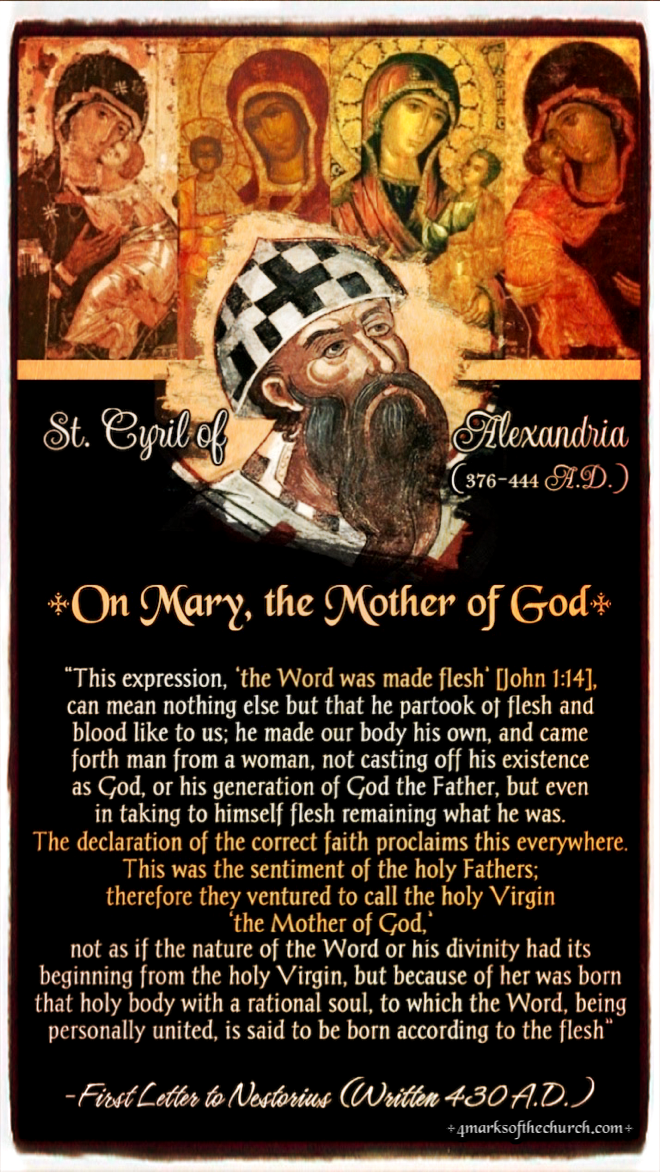
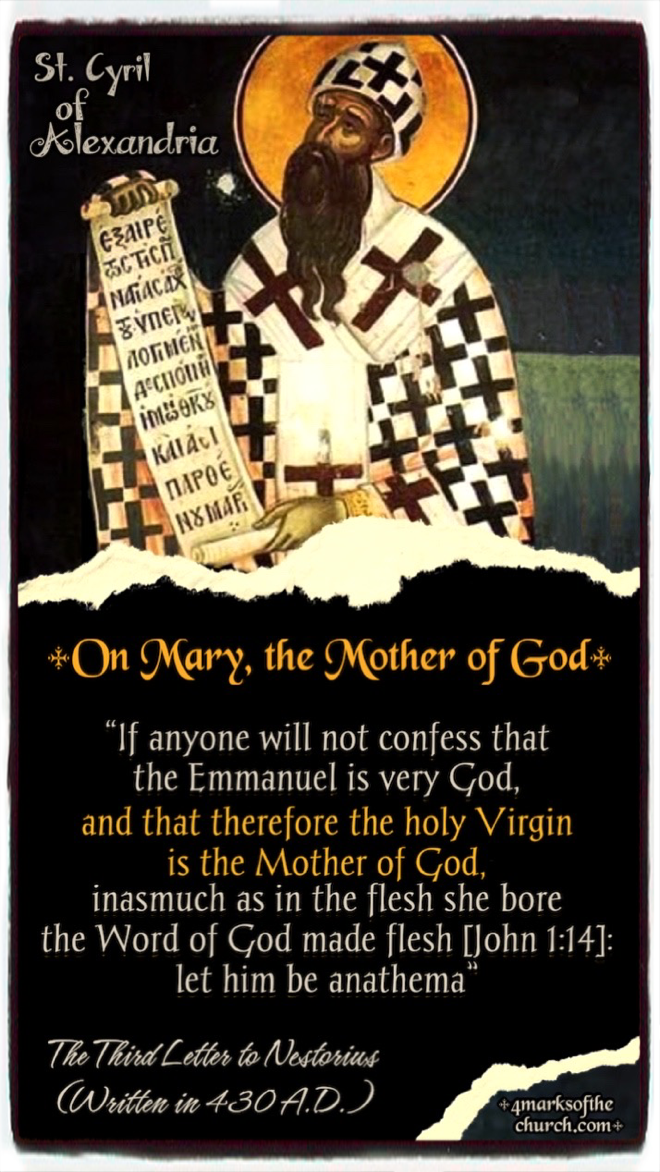
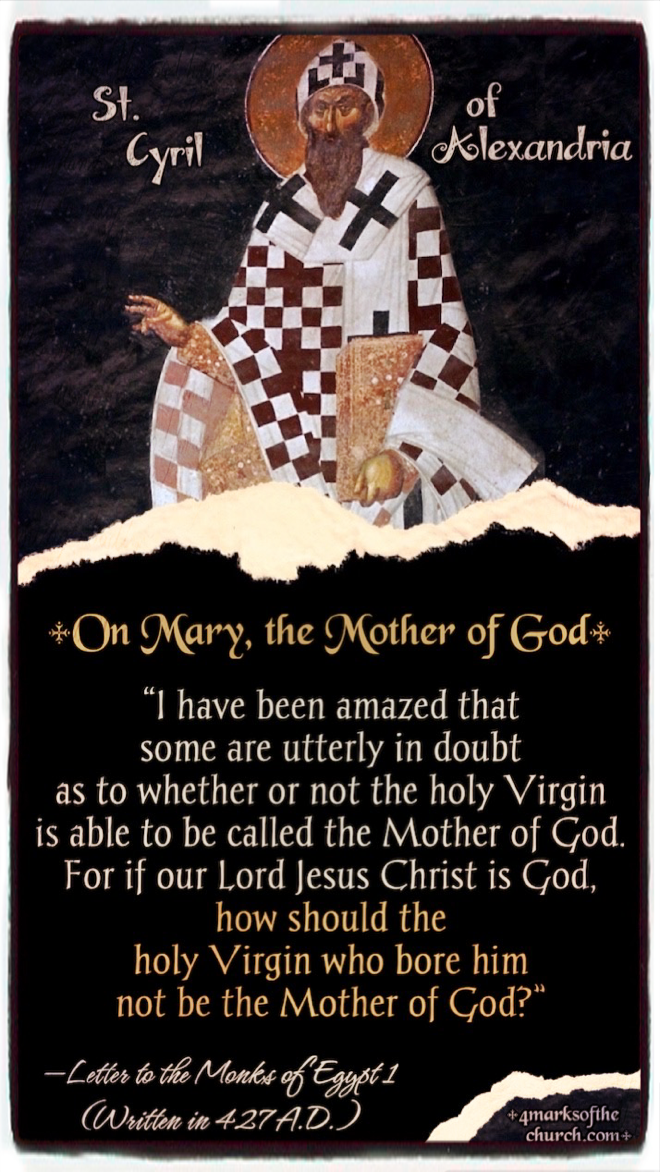
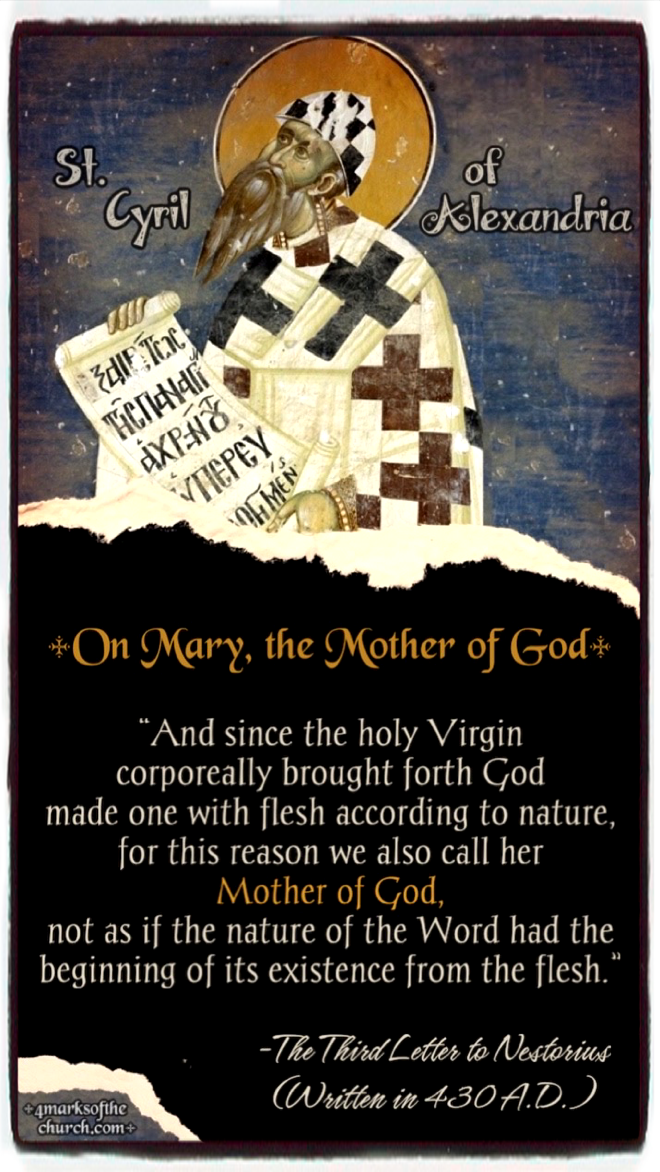
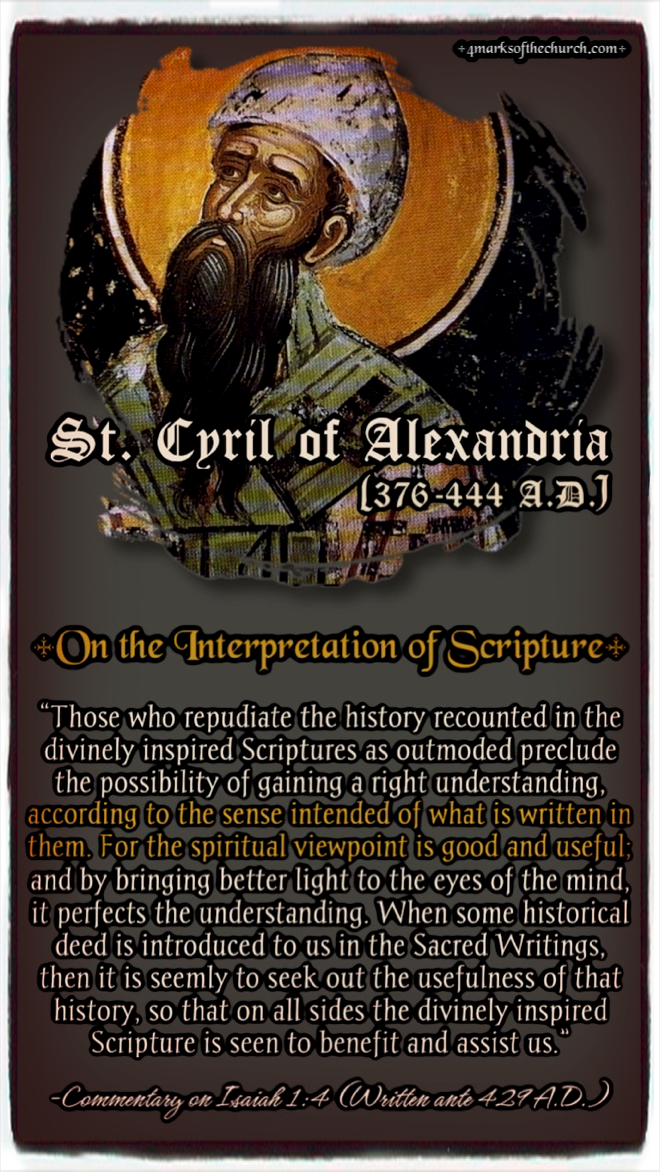

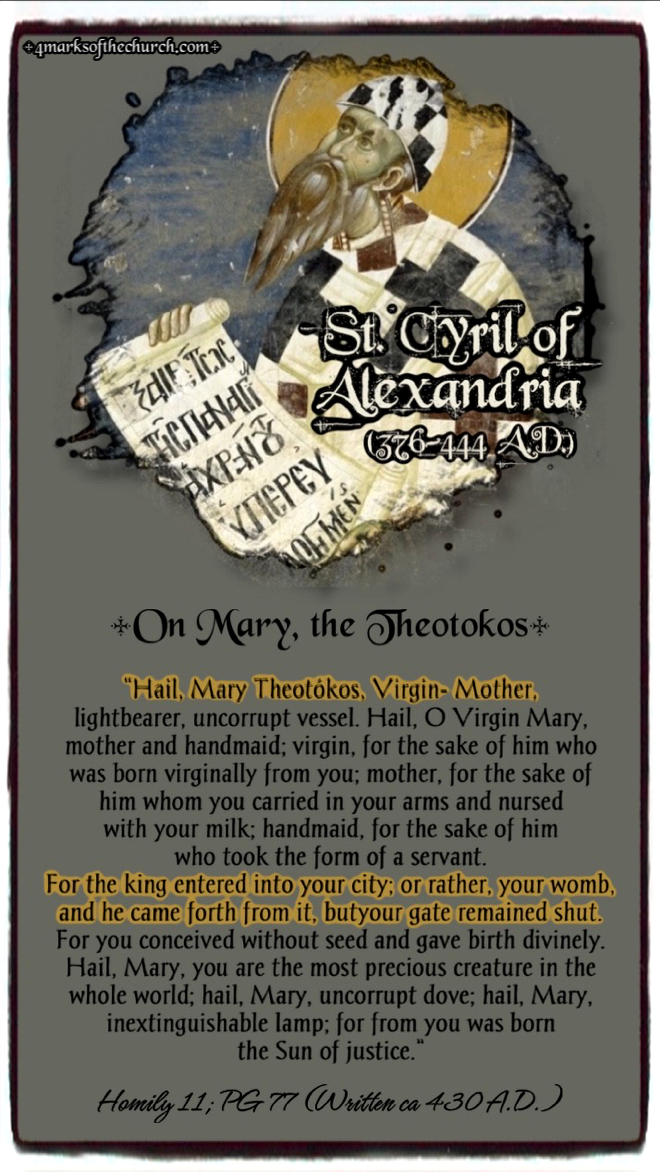
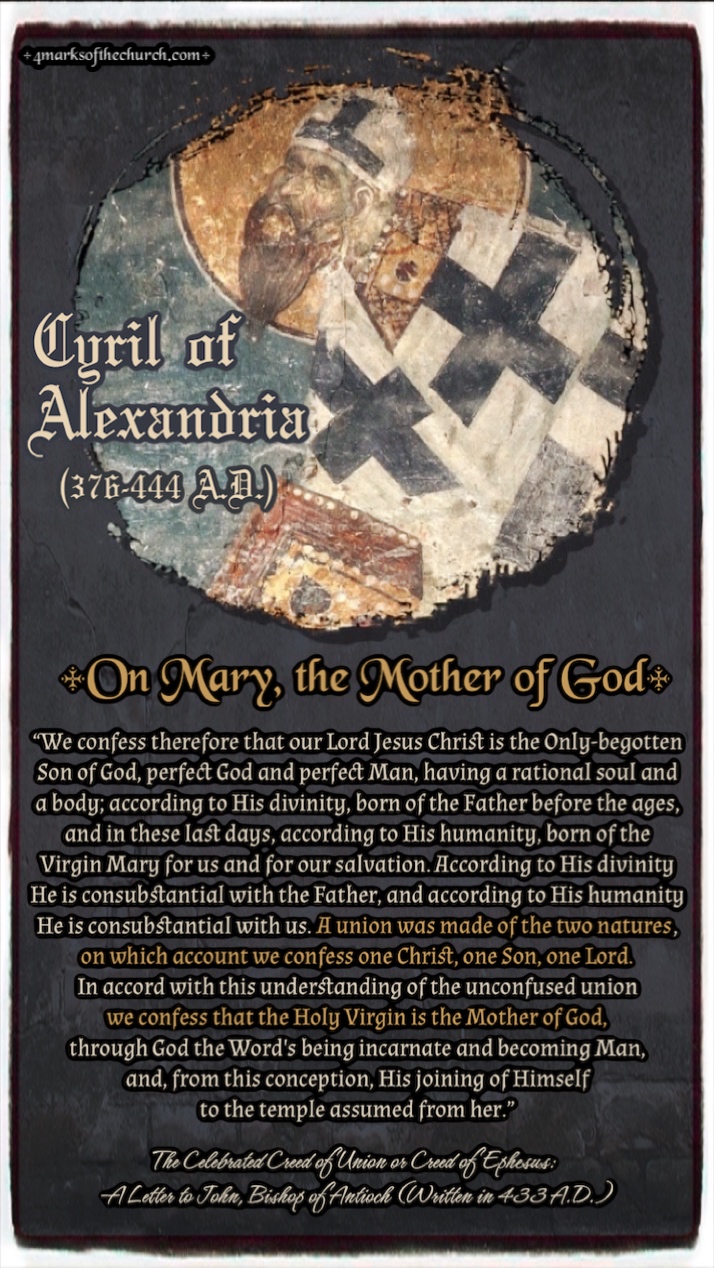

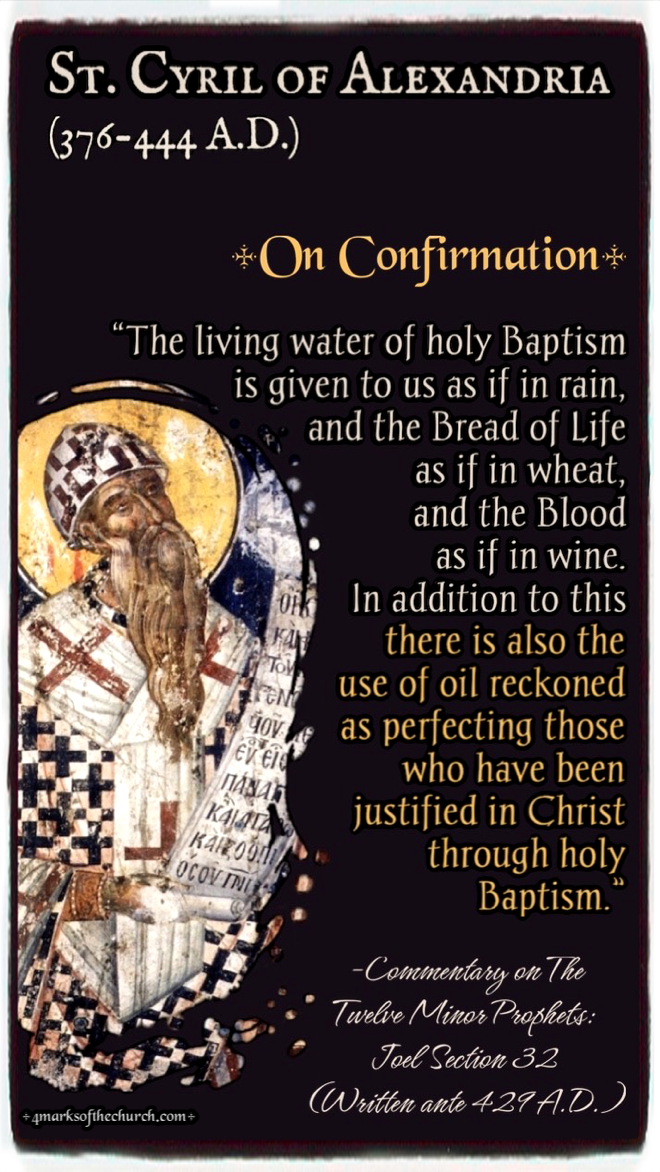
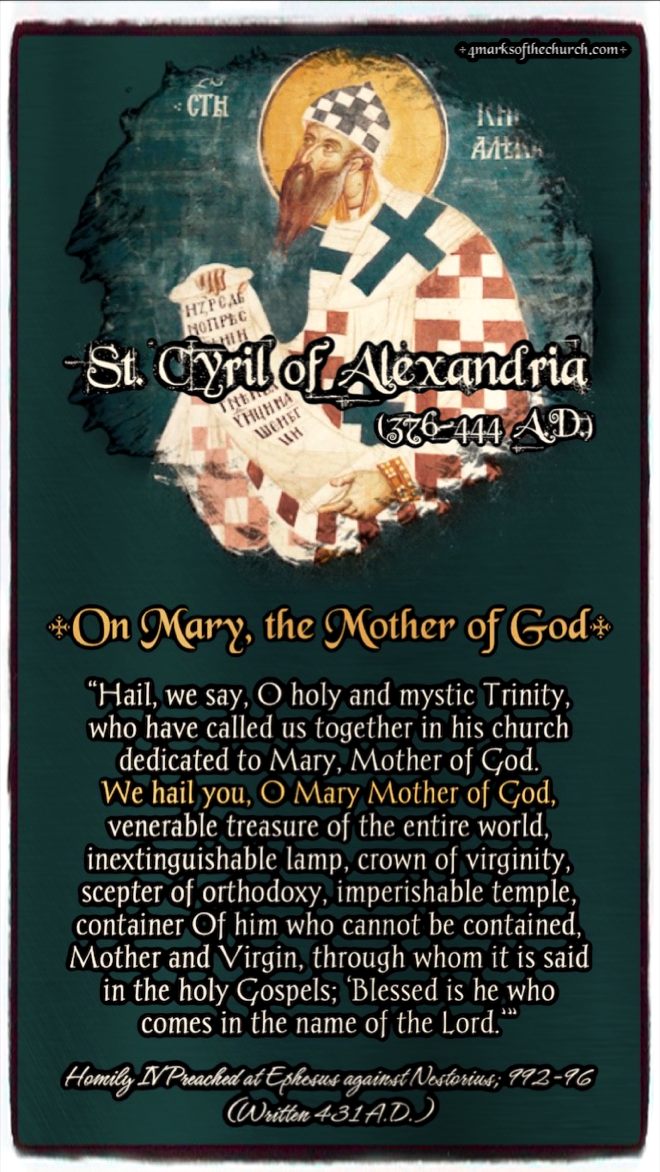
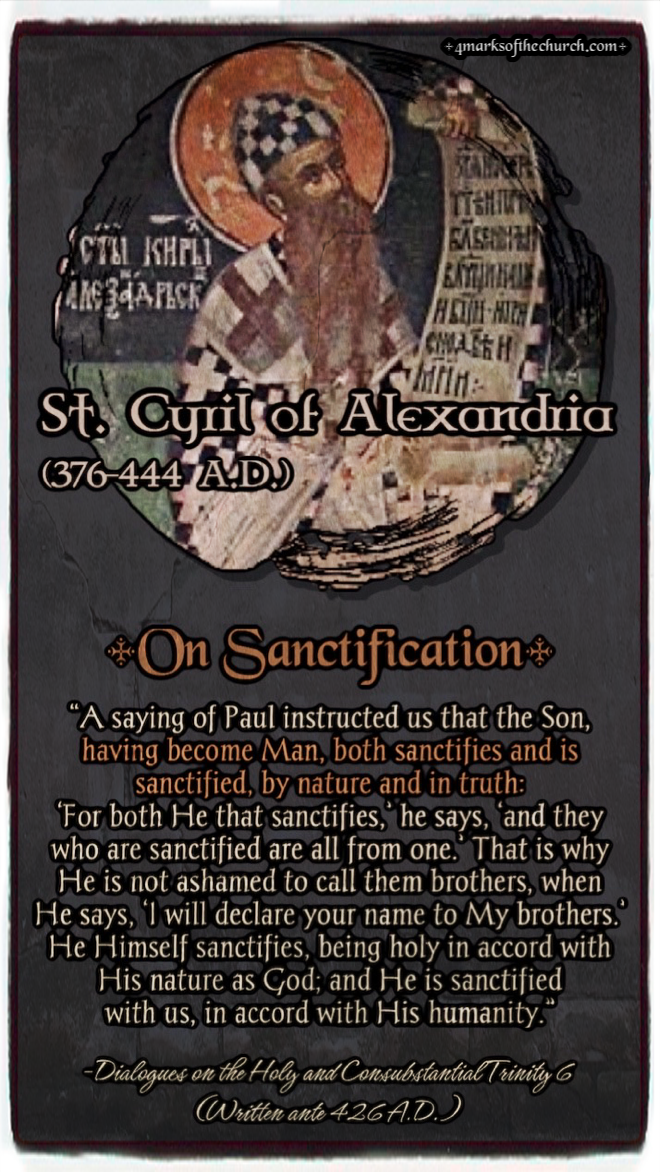
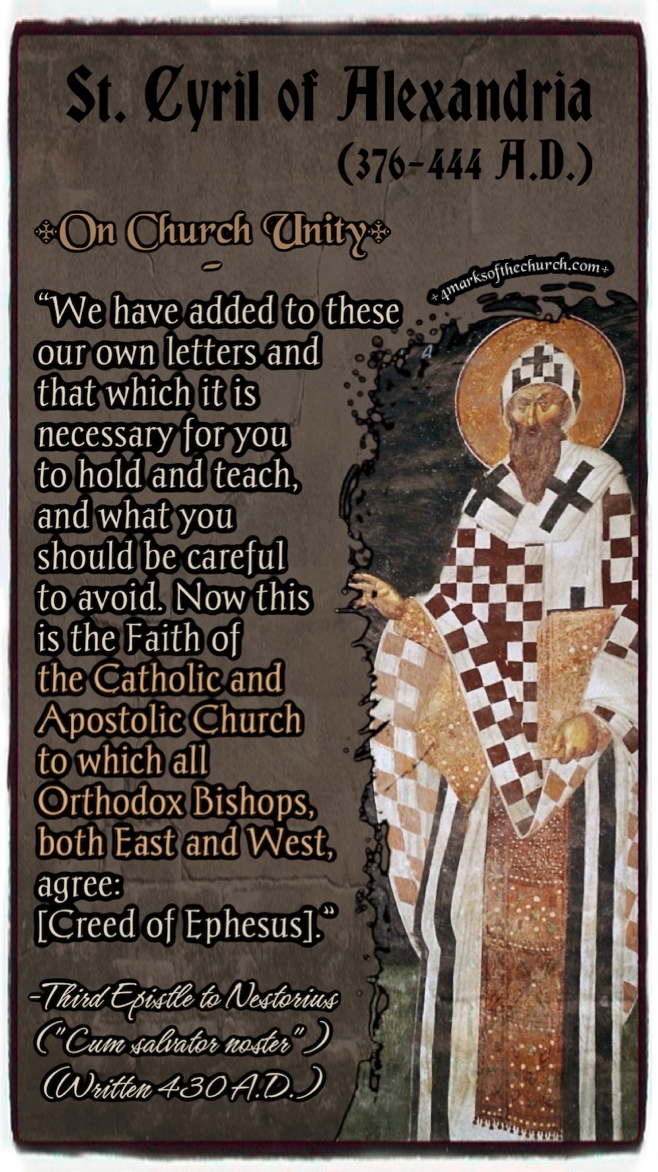
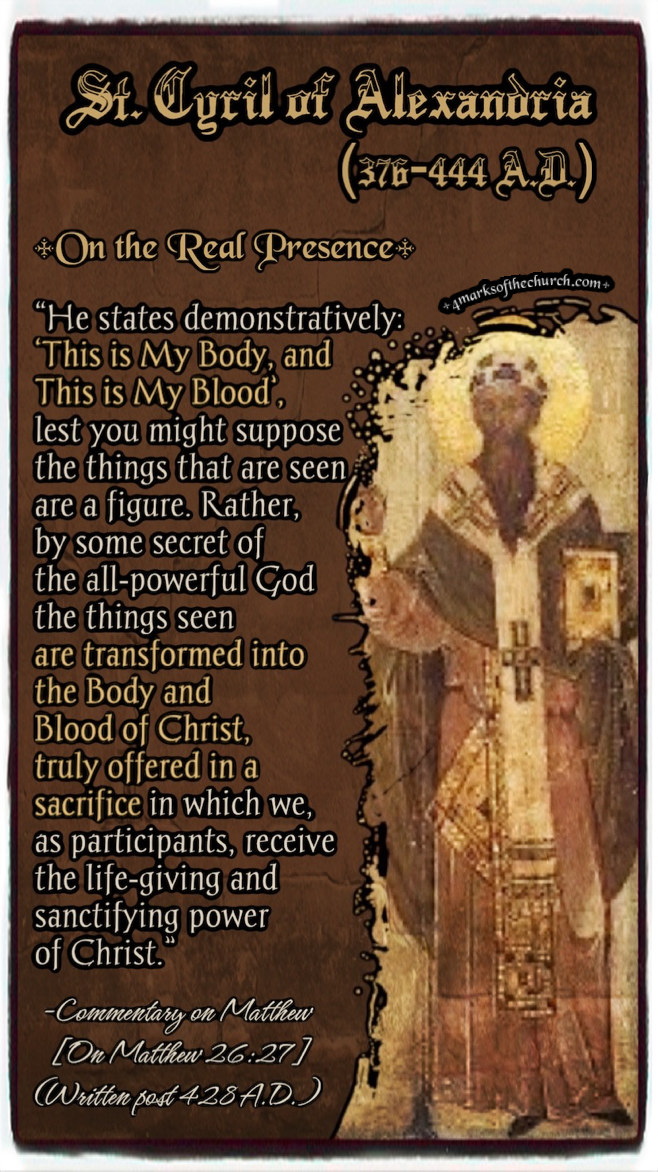

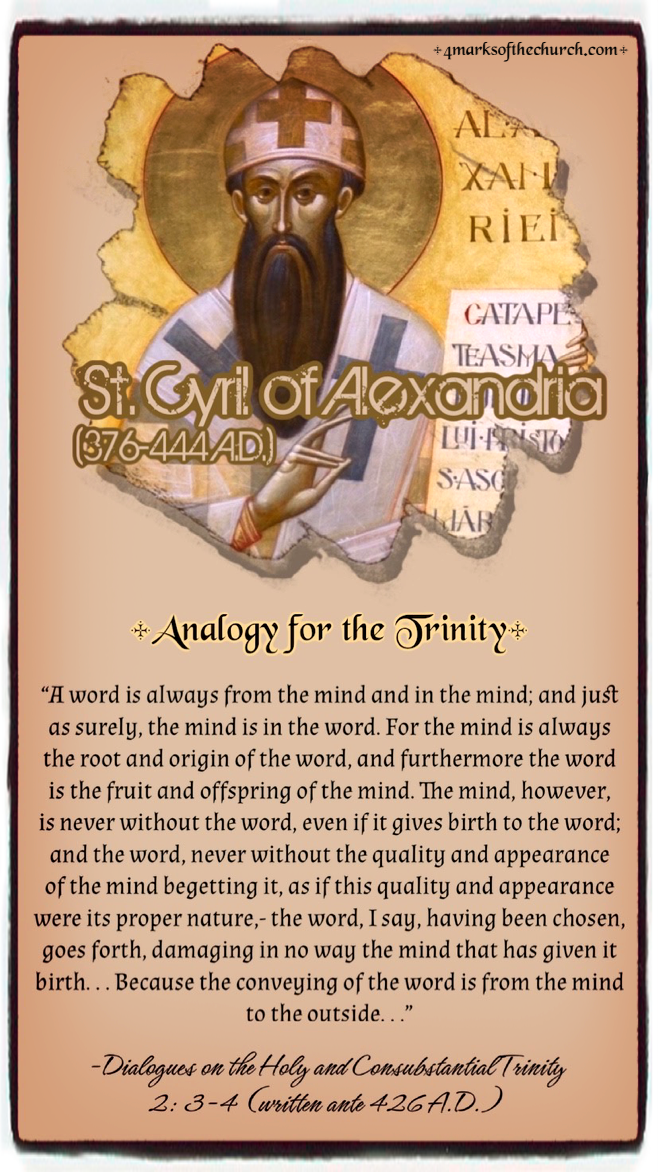

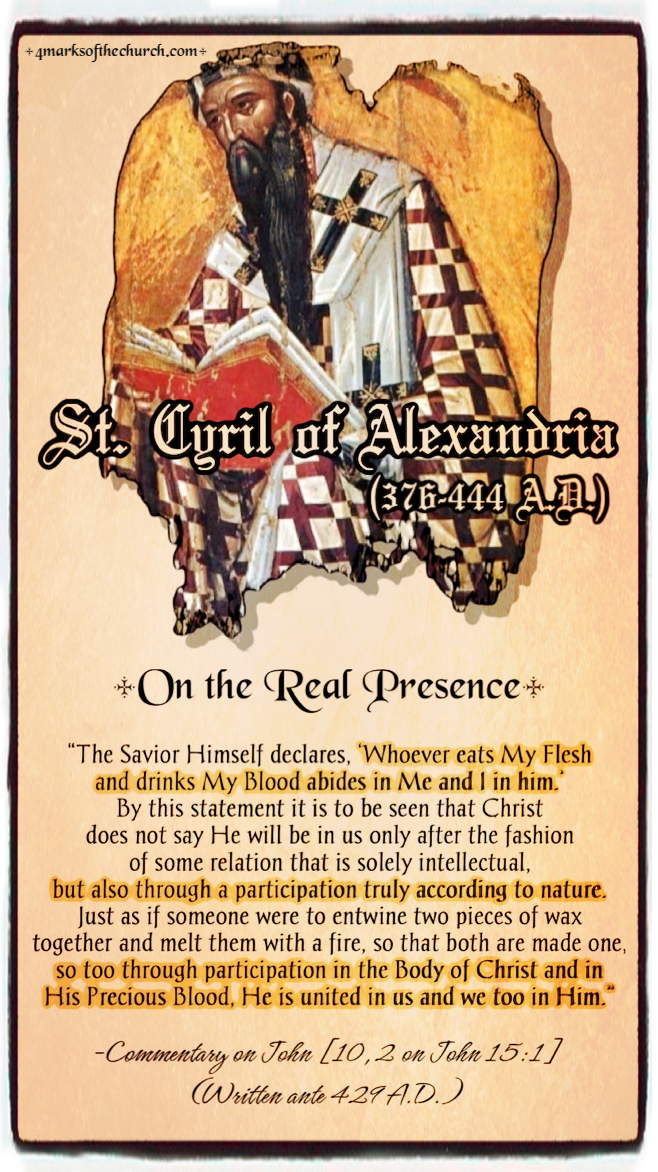
Cyril of Alexandria (376 – 444) was the Patriarch of Alexandria from 412 to 444. Cyril wrote extensively and was a leading antagonist in the Christological controversies of the late-4th and 5th centuries, especially with Nestorius, the Patriarch of Constantinople. He was a central figure in the Council of Ephesus in 431, which led to the deposition of Nestorius as Patriarch of Constantinople. The Council of Ephesus was convened in 431 A.D. due to the controversy that arose from Nestorius’ rejection of Mary’s ancient title of “Theotokos” or “God-Bearer”, on the basis that it implied that Mary was the origin of the Godhead. In it’s place, Nestorius proposed the title of “Christotokos” or Christ-Bearer. This theological position, which became known as Nestorianism, garnered much criticism, as it came on the heels of other Christological heresies such as Arianism. The issue at hand had less to do with Christ’s Virgin Mother, and more to do with Christ Himself. Cyril of Alexandria charged him with detaching Christ’s divinity and humanity into two persons existing in one body, thereby denying the reality of the Incarnation and the premise that a mother gives birth to a person, not a body. For example, when Christ thirsted, He said “I thirst”, not “my human body thirsts.”
Cyril appealed to Pope Celestine I, charging Nestorius with heresy. The Pope agreed and gave Cyril his authority to serve a notice to Nestorius to recant his views within ten days or else be excommunicated. Before acting on the Pope’s commission, Cyril convened a synod of Egyptian bishops which condemned Nestorius as well. Cyril then sent four suffragan bishops to deliver both the Pope’s commission as well as the synodal letter of the Egyptian bishops. Cyril sent a letter to Nestorius known as “The Third Epistle of Saint Cyril to Nestorius.” This epistle drew heavily on the established Patristic Constitutions and contained the most famous article of Alexandrian Orthodoxy: “The Twelve Anathemas of Saint Cyril.” In these anathemas, Cyril excommunicated anyone who followed the teachings of Nestorius. Some of Nestorius’ early supporters, such as John of Antioch (then the Patriarch of Antioch), Theodoret of Cyr and Andrew of Samosata were able to recognize “the point of the argument for Christ’s integrity” and concede the “ill-advised nature of Nestorius’ immoveability. Concerned at the potential for a negative result at a council, they urged Nestorius to yield and accept the use of the title Theotokos when referring to the Virgin Mary. John of Antioch wrote to Nestorius urging him to submit to the Pope’s judgment and cease stirring up controversy over a word that he disliked (Theotokos) but which could be interpreted as having an orthodox meaning especially in light of the fact that many saints and doctors of the church had sanctioned the word by using it themselves. John wrote to Nestorius, “Don’t lose your head. Ten days! It will not take you twenty-four hours to give the needed answer…. Ask advice of men you can trust. Ask them to tell you the facts, not just what they think will please you…. You have the whole of the East against you, as well as Egypt.” Despite this advice from his colleagues, Nestorius persisted in maintaining his position. John of Antioch would ultimately be excluded from the Council of Ephesus by Cyril for arriving late.
Cyril is also known for his expulsion of Novatians and Jews from Alexandria and for inflaming tensions that led to the murder of the Hellenistic philosopher Hypatia by a Christian mob. A mob, led by a lector named Peter, took Hypatia from her chariot and murdered her, hacking her body apart and burning the pieces outside the city walls. According to historian Bryan J. Whitfield in “The Beauty of Reasoning: A Reexamination of Hypatia and Alexandria”, the pagan Neoplatonist named Damascius (c. 458-538) was “anxious to exploit the scandal of Hypatia’s death”, and attributed responsibility for her murder to Bishop Cyril and his Christian followers. Damascius’s account of the Christian murder of Hypatia is the sole historical source attributing direct responsibility to Bishop Cyril. Cyril is counted among the Church Fathers and also as a Doctor of the Church, and his reputation within the Christian world has resulted in his titles Pillar of Faith and Seal of all the Fathers.
Writings:
- Second Epistle of Cyril to Nestorius
- Third Epistle of Cyril to Nestorius (containing the twelve anathemas)
- The Council of Ephesus
- Commentaries on the Old Testament
- Discourse Against Arians
- Commentary on St. John’s Gospel
- Becoming Temples of God
- Commentary on the Letter to Hebrews
- Formula of Reunion: In Brief (A summation of the reunion between Cyril and John of Antioch)
- The “Formula of Reunion”, between Cyril and John of Antioch
- Five tomes against Nestorius (Adversus Nestorii blasphemias)
- That Christ is One (Quod unus sit Christus)
- Scholia on the incarnation of the Only-Begotten (Scholia de incarnatione Unigeniti)
- Against Diodore of Tarsus and Theodore of Mopsuestia (fragments)
- Against the synousiasts (fragments)
- Commentary on the Gospel of Luke
- Commentary on the Gospel of John
- Against Julian the Apostate
- Cyrilli Alexandrini liber Thesaurus adversus hereticos a Georgio Trapesuntio traductus
return to top ⇑
Quotes and Excerpts:
Homily 11; PG 77 (Written ca 430 A.D.)
“Hail, Mary Theotókos, Virgin- Mother,
lightbearer, uncorrupt vessel. Hail, O Virgin Mary,
mother and handmaid; virgin, for the sake of him who
was born virginally from you; mother, for the sake of
him whom you carried in your arms and nursed
with your milk; handmaid, for the sake of him
who took the form of a servant.
For the king entered into your city; or rather, your womb,
and he came forth from it, butyour gate remained shut.
For you conceived without seed and gave birth divinely.
Hail, Mary, you are the most precious creature in the
whole world; hail, Mary, uncorrupt dove; hail, Mary,
inextinguishable lamp; for from you was born
the Sun of justice.”
The Celebrated Creed of Union or Creed of Ephesus:
-A Letter to John, Bishop of Antioch (Written in 433 A.D.)
“We confess therefore that our Lord Jesus Christ is the Only-begotten
Son of God, perfect God and perfect Man, having a rational soul and
a body; according to His divinity, born of the Father before the ages,
and in these last days, according to His humanity, born of the
Virgin Mary for us and for our salvation. According to His divinity
He is consubstantial with the Father, and according to His humanity
He is consubstantial with us. A union was made of the two natures,
on which account we confess one Christ, one Son, one Lord.
In accord with this understanding of the unconfused union
we confess that the Holy Virgin is the Mother of God,
through God the Word’s being incarnate and becoming Man,
and, from this conception, His joining of Himself
to the temple assumed from her.”
The Third Letter to Nestorius
(Written in 430 A.D.)
“If anyone will not confess that
the Emmanuel is very God,
and that therefore the holy Virgin
is the Mother of God,
inasmuch as in the flesh she bore
the Word of God made flesh [John 1:14]:
let him be anathema”
The Third Epistle of Cyril to Nestorius(“Cum salvator noster”)
(Written in 430 A.D.)
“Behold, therefore, how we, together with
the holy synod which met in great Rome,
presided over by the most holy and most reverend
brother and fellow-minister, Celestine the Bishop,
also testify by this third letter to you, and counsel
you to abstain from these mischievous and
distorted dogmas, which you hold and teach,
and to receive the right faith,
handed down to the churches from the beginning
through the holy Apostles and Evangelists,
who were eye-witnesses, and ministers of the Word.”
Council of Ephesus, Session II, Extracts from Acts
(Recorded 430 A.D.)
“Cyril, the bishop of Alexandria said: Let the letter
received from the most holy and altogether most blessed
Cœlestine, bishop of the Apostolic See of Rome
be read to the holy Synod with fitting honour.
Siricius, notary of the holy Catholic (καθολικῆς)
Church of the city of Rome read it. And after it was
read in Latin, Juvenal, the bishop of Jerusalem said:
Let the writings of the most holy and blessed
bishop of great Rome which have just been read,
be entered on the minutes.”
-Commentary on The
Twelve Minor Prophets:
Joel Section 32
(Written ante 429 A.D.)
“The living water of holy Baptism
is given to us as if in rain,
and the Bread of Life
as if in wheat,
and the Blood
as if in wine.
In addition to this
there is also the
use of oil reckoned
as perfecting those
who have been
justified in Christ
through holy
Baptism.”
-The Third Letter to Nestorius
(Written in 430 A.D.)
“And since the holy Virgin
corporeally brought forth God
made one with flesh according to nature,
for this reason we also call her
Mother of God,
not as if the nature of the Word had the
beginning of its existence from the flesh.”
-Commentary on Isaiah 1:4 (Written ante 429 A.D.)
“Those who repudiate the history recounted in the
divinely inspired Scriptures as outmoded preclude
the possibility of gaining a right understanding,
according to the sense intended of what is written in
them. For the spiritual viewpoint is good and useful;
and by bringing better light to the eyes of the mind,
it perfects the understanding. When some historical
deed is introduced to us in the Sacred Writings,
then it is seemly to seek out the usefulness of that
history, so that on all sides the divinely inspired
Scripture is seen to benefit and assist us.”
Scholia on the Incarnation of the Only-Begotten 26:3-6
(Written post 431 A.D.)
“The Word, then, was God, and He became also Man;
and since He was born according to the flesh for the
sake of mankind, it is necessary that she who bore Him
is the Mother of God.
For if she did not bear God, neither is He that was born
of her to be called God. If the divinely inspired Scriptures
name Him God, as God having been made Man and
incarnate, He could not become Man in any other way
than through birth from a woman:
how then should she who bore Him not be
the Mother of God?”
—Letter to the Monks of Egypt 1
(Written in 427 A.D.)
“I have been amazed that
some are utterly in doubt
as to whether or not the holy Virgin
is able to be called the Mother of God.
For if our Lord Jesus Christ is God,
how should the
holy Virgin who bore him
not be the Mother of God?”
-First Letter to Nestorius (Written 430 A.D.)
“This expression, ‘the Word was made flesh’ [John 1:14],
can mean nothing else but that he partook of flesh and
blood like to us; he made our body his own, and came
forth man from a woman, not casting off his existence
as God, or his generation of God the Father, but even
in taking to himself flesh remaining what he was.
The declaration of the correct faith proclaims this everywhere.
This was the sentiment of the holy Fathers;
therefore they ventured to call the holy Virgin
‘the Mother of God,’
not as if the nature of the Word or his divinity had its
beginning from the holy Virgin, but because of her was born
that holy body with a rational soul, to which the Word, being
personally united, is said to be born according to the flesh”
-Against Those Who Do Not Wish to Confess
That the Holy Virgin is the Mother of God 4
(Written 430 A.D.)
“[T]he Word himself,
coming into the Blessed Virgin herself,
assumed for himself his own temple
from the substance of the Virgin and
came forth from her a man in all that
could be externally discerned,
while interiorly he was true God.
Therefore he kept his Mother a virgin
even after her childbearing”
-Dialogues on the Holy and Consubstantial Trinity 6
(Written ante 426 A.D.)
“A saying of Paul instructed us that the Son,
having become Man, both sanctifies and is
sanctified, by nature and in truth:
‘For both He that sanctifies,’ he says, ‘and they
who are sanctified are all from one.’ That is why
He is not ashamed to call them brothers, when
He says, ‘I will declare your name to My brothers.’
He Himself sanctifies, being holy in accord with
His nature as God; and He is sanctified
with us, in accord with His humanity.”
Homily IV Preached at Ephesus against Nestorius; 992-96
(Written 431 A.D.)
“Hail, we say, O holy and mystic Trinity,
who have called us together in his church
dedicated to Mary, Mother of God.
We hail you, O Mary Mother of God,
venerable treasure of the entire world,
inextinguishable lamp, crown of virginity,
scepter of orthodoxy, imperishable temple,
container Of him who cannot be contained,
Mother and Virgin, through whom it is said
in the holy Gospels; ‘Blessed is he who
comes in the name of the Lord.’”
-Commentary on Matthew
[On Matthew 26:27]
(Written post 428 A.D.)
“He states demonstratively:
‘This is My Body, and
This is My Blood’,
lest you might suppose
the things that are seen
are a figure. Rather,
by some secret of
the all-powerful God
the things seen
are transformed into
the Body and
Blood of Christ,
truly offered in a
sacrifice in which we,
as participants, receive
the life-giving and
sanctifying power
of Christ.”
-Third Epistle to Nestorius
(“Cum salvator noster”)
(Written 430 A.D.)
“We have added to these
our own letters and
that which it is
necessary for you
to hold and teach,
and what you
should be careful
to avoid. Now this
is the Faith of
the Catholic and
Apostolic Church
to which all
Orthodox Bishops,
both East and West,
agree:
[Creed of Ephesus].”
-Dialogues on the Holy and Consubstantial Trinity
2: 3-4 (written ante 426 A.D.)
“A word is always from the mind and in the mind; and just
as surely, the mind is in the word. For the mind is always
the root and origin of the word, and furthermore the word
is the fruit and offspring of the mind. The mind, however,
is never without the word, even if it gives birth to the word;
and the word, never without the quality and appearance
of the mind begetting it, as if this quality and appearance
were its proper nature,- the word, I say, having been chosen,
goes forth, damaging in no way the mind that has given it
birth. . . Because the conveying of the word is from the mind
to the outside. . .”
Treasury of the Holy Trinity,
thesis 34
(Written in 424 A.D.)
“Since the Holy Spirit
when he is in us
effects our being
conformed
to God,
and he actually
proceeds from the
Father and Son,
it is abundantly
clear that he is of
the divine essence,
in it in essence
and proceeding
from it.”
-Commentary on John [10, 2 on John 15:1]
(Written ante 429 A.D.)
“The Savior Himself declares, ‘Whoever eats My Flesh
and drinks My Blood abides in Me and I in him.’
By this statement it is to be seen that Christ
does not say He will be in us only after the fashion
of some relation that is solely intellectual,
but also through a participation truly according to nature.
Just as if someone were to entwine two pieces of wax
together and melt them with a fire, so that both are made one,
so too through participation in the Body of Christ and in
His Precious Blood, He is united in us and we too in Him.”
-Commentary on John 2, I; PG 73, 225.
(Written ca 429 A.D.)
“Further, Christ shows that
the greatest possible honor is
owed to parents by the fact that,
out of respect for his Mother,
he decided to work a miracle
that he had not wanted to perform.”
return to top ⇑